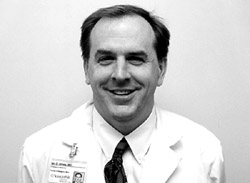
Dr. Ian Jones
Jones offers doctors bioterrorism lesson
Vanderbilt physicians got a quick lesson on bioterrorism last week during the Department of Surgery Grand Rounds.
Speaking before a very attentive audience, Dr. Ian Jones, assistant professor of Emergency Medicine and operations director for the Vanderbilt Emergency Department, told fellow physicians of the threat of bioterrorism, as well as the treatment and resources available.
Jones said the threat of bioterrorism had been around since the sixth century B.C., when the Assyrians poisoned the wells of their enemies with rye ergot.
Since the Sept. 11 attacks and the ensuing cases of anthrax exposure, America has been on heightened alert for additional threats of bioterrorism.
“The threat is real,” Jones said. “The Russians had a sophisticated bioweapons facility in Koltsovo, Novosibirsk. Throughout the 1990s, this was a 4,000-person, 30-building facility that concentrated on building bioweapons.”
However since then, a visit by U.S. officials in 1997 found only a handful of guards and a half-empty facility. Officials aren’t sure where the scientists have gone and what happened to some of the bioweapons produced.
Jones briefed the doctors on what to expect with clinical presentations for anthrax, plague, smallpox, viral hemorrhagic fevers and botulism, and outlined treatment procedures for each of these diseases.
Some of the symptoms of the diseases unfortunately could be undetectable for up to 60 days, according to Jones, resulting in a delay of treatment.
“However, it is important to always consider the exposure history,” he explained. “If we know the patient has been in an area that has had a known anthrax exposure and they are exhibiting symptoms, we need to immediately admit them and begin treatment. However, if they have not been in a known exposure area, we would be far less likely to entertain the diagnosis of anthrax.”
Jones, who has helped write the Vanderbilt response plan on bioterrorism, said a draft of the final plan would be tested within the next month. He has been assisted in training adult and pediatric emergency room staff by Dr. Robin Hemphill, assistant professor of Emergency Medicine, and Dr. Robert Janco, assistant professor of Pediatrics.
“We have enhanced our pharmaceutical stocks, implemented a vigorous training plan, and increased our interaction with local and state response agencies,” he said. “We’ve actually been doing much of this for the last two years, but of course now it’s on the fast track.”
One of the doctors pointed out that further attacks could overload an already taxed health care system.
“That’s true,” Jones replied. “No hospital in this county is prepared for the surge of patients that might bring and long-term operations under those conditions. We need to look to the federal government to help increase the overall number of health care professionals and available hospital beds.”













